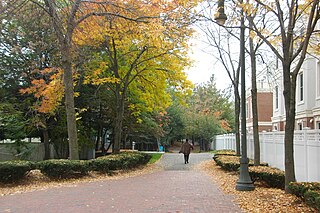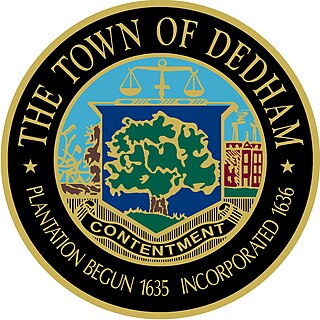Related Research Articles

The Taunton River watershed or Taunton River basin is made up of 562 square miles (1,500 km2) of rivers, lakes, ponds, streams, and wetlands in southeastern Massachusetts, US. It is the second largest watershed in the state. Also, it is a significant part of a much larger multi-state watershed, the Narragansett Bay watershed.

Readville is part of the Hyde Park neighborhood of Boston. Readville's zip code is 02136. It was called Dedham Low Plains from 1655 until renaming in 1847 after mill owner James Read. It was part of Dedham until 1867. It is served by Readville station on the MBTA Commuter Rail. It is on the original alignment of Route 128, later part of a since-discontinued section of Route 135. Readville is bordered by the Town of Milton to the south and Town of Dedham to the west. Paul's Bridge, which is at the neighborhood's entrance as one approaches from Milton, is one of the oldest bridges in the Commonwealth. The name comes from James Read, a resident and cotton mill owner. Readville is covered by Boston Police Department District E-18 in Hyde Park and a fire station on Neponset Valley Parkway houses Boston Engine Company 49. Readville is also home to several light industries.

Browning Pond is located in Oakham and Spencer, Massachusetts. This 89-acre (360,000 m2) great pond forms the headwaters of the Seven Mile River. It is part of the Chicopee River Watershed.

Fresh Pond was a small middle class neighborhood in the New York City borough of Queens, separated from Juniper Valley by the Lutheran and Mount Olivet cemeteries. In present day, it is now considered part of the surrounding neighborhoods of Maspeth, Middle Village, Glendale, and Ridgewood and is no longer referred to by the name "Fresh Pond." The area was originally named for two freshwater ponds that, in the early 1900s, were filled in. Other ponds were lower, and brackish due to Newtown Creek being estuarine.

West Cambridge, also known as "Area 10", is a neighborhood in Cambridge, Massachusetts. It is bounded by the Charles River on the south, JFK Street on the east, Concord Avenue on the north, and Fresh Pond, Aberdeen Avenue, and the Watertown line on the west.

North Cambridge, also known as "Area 11", is a neighborhood of Cambridge, Massachusetts bounded by Porter Square and the Fitchburg Line railroad tracks on the south, the city of Somerville on the northeast, Alewife Brook and the town of Arlington on the northwest, and the town of Belmont on the west. In 2005 it had a population of 10,642 residents living in 4,699 households, and the average income was $44,784. In 2010, the racial demographics for the neighborhood were 57.6% White, 20% Black, 15.1% Asian/Pacific Islander, 7.3% Hispanic origin, 0.3% Native American, 2.4% other race.
Cambridge Highlands also known as "Area 12", is a neighborhood of Cambridge, Massachusetts bounded by the railroad tracks on the north and east, the Belmont town line on the west, and Fresh Pond on the south. In 2005 it had a population of 673 residents living in 281 households, and the average household income was $56,500.

Strawberry Hill, also known as Area 13, is a neighborhood in Cambridge, Massachusetts. It is bounded by the town of Belmont on the west, Watertown on the south, Aberdeen Avenue on the east, and Fresh Pond on the north. In 2017 it had a population of 2,585 residents living in 1,061 households, and the average household income was $74,107. The altitude is around 114 feet above sea level making it the highest natural altitude in Cambridge.

Stony Brook is a stream largely running through Lincoln and Weston, Massachusetts, then forming the Weston/Waltham boundary, and emptying into the Charles River across from the Waltham/Newton boundary. It has two tributaries, Cherry Brook and Hobbs Brook, and its watershed includes about half of Lincoln and Weston as well as parts of Lexington and Waltham. Since 1887, it has been the water supply for Cambridge.
Camp Chase, also known as Camp Wilson, was a training camp for Massachusetts militia during the American Civil War located in Lowell, Massachusetts. Several thousand recruits were trained at Camp Chase before being sent south to the battle front.
Camp Edwin M. Stanton was an American Civil War training camp that existed from 1861-1862 in Lynnfield, Massachusetts. When the camp first opened in 1861 it was known as Camp Schouler, named for Massachusetts Adjutant General William Schouler. In some references it is mis-spelled as Camp Schuyler. After President Abraham Lincoln's call for 300,000 troops in July 1862, the camp was revived and renamed in honor of United States Secretary of War Edwin M. Stanton. It served as the training camp and rendezvous for recruits from eastern Massachusetts. The camp trained ten infantry regiments and four artillery batteries of the Massachusetts militia, including the 17th, 19th, 22nd, 23rd, 33rd, 35th, 38th, 39th, 40th, and 41st regiments of infantry and the 3rd, 5th, 9th, and 10th batteries of light artillery. Soldiers stationed at Camp Schouler/Stanton during training included Edward A. Wild, Henry Wilson, Nelson A. Miles, Edward Winslow Hinks, and Arthur F. Devereux. During World War I it was renamed Camp Houston and served as a Massachusetts National Guard mobilization camp in 1917. It was located on the Newburyport Turnpike near the Peabody, Massachusetts line. The camp was divided into streets, with tents and cook houses located on both sides of the Turnpike to Suntaug Lake.
Camp Adams was a former American Civil War training camp that existed in 1861 in Quincy, Massachusetts. It was first occupied on 5 July 1861 by Cobb's Light Artillery. On 8 August the unit relocated to Baltimore, Maryland and established Camp Andrew.
Camp Andrew is a former American Civil War training camp that existed in 1861 in West Roxbury, Massachusetts. It was named for John A. Andrew, governor of Massachusetts at the time, and was used for the initial organization of the 2nd Massachusetts Infantry Regiment in May–July 1861. The site was on the former Brook Farm, a utopian community from 1841 through 1847. As a youth, Robert Gould Shaw was taken on visits to Brook Farm by his father. He is most famous as the commander of the 54th Massachusetts Infantry Regiment. In his early military career he trained at Camp Andrew as an officer of the 2nd Massachusetts.
Camp Cameron was an American Civil War training camp that existed in 1862 in North Cambridge, Massachusetts. It was used for the initial organization of elements of the 38th Massachusetts Infantry Regiment. It was probably named for Simon Cameron, Lincoln's first secretary of war. Other units that trained here included the 1st, 11th, 16th, 26th, and 28th regiments of Massachusetts infantry, and the 1st and 8th batteries of light artillery. It was located near Massachusetts Avenue, and was also known at one point as Camp Day after the family that owned the land. Cameron Avenue and Camp Street are named for the camp, and several nearby streets were named after battles.

Camp Meigs is a former American Civil War training camp that existed from 1862 to 1865 in Readville, Massachusetts. It was combined from the former Camp Brigham and Camp Massasoit and trained the 54th Regiment Massachusetts Volunteer Infantry, among others. The 54th regiment was one of the first official African-American units in the United States during the Civil War. The former camps were merged into Camp Meigs in August 1862.
Camp Prospect Hill was a former American Civil War training camp that existed in 1861 in Somerville, Massachusetts. It was located on Prospect Hill in the Union Square neighborhood of Somerville, on the site of an American Revolutionary War fort. Company E of the 39th Massachusetts Volunteer Infantry Regiment trained there.
Camp Framingham is a former Massachusetts National Guard camp that existed in 1873 to 1944 in Framingham, Massachusetts, also called Camp Dalton or Fort Dalton until 1898. The camp was used by all units of the Massachusetts Volunteer Militia as their summer training ground. The camp also contained a state arsenal where weapons and equipment was stored and issued to units. Fort Dalton was a training battery from 1883 to 1898, 138 feet (42 m) long with two 10 in (254 mm) Rodman guns and four siege mortars. Camp Framingham was used as a mobilization station during the Spanish–American War, in June 1916 during the Mexican border call-up and in the summer of 1917 during World War I. Other names for the camp in the Spanish–American War were Camp McGuinness and Camp Dewey. From May 1942 to December 1943, Headquarters, 181st Infantry Regiment was stationed with its companies serving on coast patrol duty for the Eastern Defense Command in New England. In 1948, Camp Framingham was transferred from the Military Division to the Massachusetts State Police. Today, the Massachusetts State Police and the Massachusetts Emergency Management Agency utilize portions of the former camp.
Camp Lincoln was an American Civil War camp that existed in 1861 in Worcester, Massachusetts. It was located on the Agricultural Fairgrounds, around the Elm Park neighborhood. It was named after Levi Lincoln Jr., the 13th Governor of Massachusetts and first Mayor of Worcester. On June 3, 1862 the camp was renamed Camp Wool, in honor of John E. Wool, the oldest general in the regular army. Units trained here included the 21st, 25th, 34th, 36th, 49th, 51st, and 57th regiments of Massachusetts infantry. Camp Scott, named for Major General Winfield Scott, also existed in Worcester for about 6 weeks in June–August 1861 as a training camp for the 15th Massachusetts Infantry Regiment.

The Old Village Cemetery is an historic cemetery in Dedham, Massachusetts.
Thomas W. Danehy Park is a park in north Cambridge, Massachusetts. Its eastern entrance is at 99 Sherman Street. It is bounded on the north by the MBTA Fitchburg Line and to the west by Fresh Pond Mall.
References
- ↑ "Massachusetts". American Forts Network . Retrieved 6 October 2013.
- ↑ "A Brief Chronology of Fresh Pond". Friends of Fresh Pond. Retrieved October 1, 2016.
- ↑ Bowen, James Lorenzo. Massachusetts in the War, 1861-1865. C.W. Bryan & Co., 1888. p. 100
